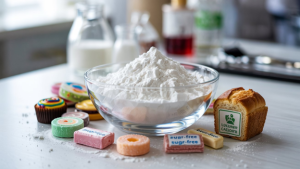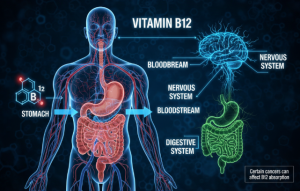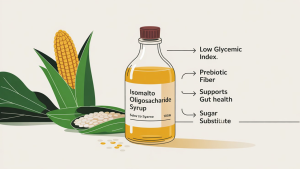What Foods Have Maltodextrin?
Author:Bobbi Langkamp-Henken, PhD, RD
Dr. Langkamp-Henken worked for six years as a hospital dietitian before she pursued a doctorate in gastrointestinal physiology and a postdoctoral fellowship in immunology from the University of Tennessee Health Science Center. Currently, Dr. Langkamp-Henken is a Professor in the Food Science and Human Nutrition Department. Her main research interest is to develop novel approaches to examine the effect of dietary interventions on health outcomes in healthy children and adults.
Ongoing interventional studies explore the impact of whole foods, fermentable fibers, and probiotics on gastrointestinal and immunological functions important for maintaining health and quality of life. Dr. Langkamp-Henken also teaches a two-semester graduate research planning course.

What Exactly Is Maltodextrin?
Definition and Chemical Structure
Simply put, maltodextrin is the kind of polysaccharide, which may sound a bit complicated, but in fact it is the kind of carbohydrate hydrolyzed from starch.
Our common corn, wheat, potato or rice starch can be its raw materials. Its chemical structure is between intact starch and simple monosaccharides, and it is made up of D-glucose units. It can be imagined as a string of pearls, starch is a long string of, monosaccharide is the pearl, and maltodextrin is the appearance of several or more than a dozen pearls linked together.
Production process
The production process of maltodextrin is actually not too mysterious. The hydrolysis of starch is mainly carried out by enzymes or acids. This process will break up long chains of starch molecules into shorter fragments. After the hydrolysis is completed, after a series of purification and drying steps, the white powder maltodextrin we see is finally obtained.
Main features and functions
Maltodextrin is widely used in the food industry precisely because it possesses some very practical properties:
- Quick digestion and absorption: This is a key point. Maltodextrin usually has a relatively high glycemic index (GI), which means that it is quickly digested and absorbed by the body, quickly converted into glucose, resulting in a rapid rise in blood sugar levels. This can be an advantage for people who need instant energy replenishment, such as athletes.
- Thickener & Stabilizer: It gives food a better texture, increases viscosity and makes the taste fuller. At the same time, it also helps prevent crystallization in food, such as in ice cream, helps to maintain its smooth texture, and extends shelf life.
- Fillers vs Carriers: In many powdered foods, maltodextrin can be used as a cost-effective filler, increasing the volume of the product. In addition, it is able to act as a carrier for essences, pigments or other active ingredients, helping them to disperse uniformly and maintain stability.
- Providing energy: As a carbohydrate, maltodextrin certainly also provides energy to the body, but as mentioned earlier, this energy release is quite rapid.
Difference from “sugar”
While maltodextrin is not technically classified as a “sugar” (usually referring to monosaccharides or disaccharides such as sucrose, glucose, fructose, etc.), it is digested and absorbed in the body in a manner very similar to sugar, with equally rapid and significant effects on blood sugar. So, when considering glycemic management or energy intake, we should think of it as a fast-absorbing carbohydrate that needs to be consumed in moderation, just like sugar.
Maltodextrin Foods List: What Foods Commonly Contain It?
As a nutritionist, I often review ingredient lists for various foods. I discovered that maltodextrin is really a “panacea” player, and it appears in all kinds of unexpected foods in our daily lives.

Prepackaged snacks & processed foods
When it comes to snacks, what do you think of first? Potato chips, puffed foods, cookies? That’s right, in these delicious snacks, maltodextrin often plays the role of improving the taste and increasing the crispiness. It makes the chips crunchier and the cookies softer. And those sweets, chocolate bars, maltodextrin sometimes acts as a filler to help regulate the sweetness and make the taste more balanced.
As for energy bars and protein bars, maltodextrin has also become a regular customer in order to provide a quick source of energy and improve texture. For example, if you pick up a pack of classic XX potato chips, turn over to the back and look at the topping list, you will most likely find it.

Beverages & Granules
If you’re a sports enthusiast, you might drink sports drinks or energy drinks a lot. Maltodextrin is an important source of carbohydrates in these products, quickly replenishing the energy the body needs. And the instant coffee, tea, and even milkshake powder for breakfast that we drink daily, maltodextrin can improve their solubility and make them taste more mellow. Like some meal replacement powders, nutritional supplements, it is also often used as a filler or energy source.

Condiments and sqauces
This category may not be noticed by many people. For example, home salad dressing, tomato sauce, barbecue sauce, maltodextrin is often used to thicken, emulsify, so that the texture of the sauce is more stable, more smooth taste. There are also those convenient soup bags and seasoning mixtures, which may also serve as a carrier or anti-caking agent to keep the seasoning from moisture and caking.

Bakery products and desserts
Friends who like to bake their own may find that maltodextrin is often found in prefabricated cake powder and Pudding powder. It improves the texture of the baked product, making the cake more fluffy and the pudding smoother. In ice cream, it can even prevent the formation of ice crystals, so that the ice cream taste more delicate, but also can increase the volume of the product.

Baby Food & Formula
This is a special area that requires our special attention. Maltodextrin is also used as a carbohydrate source in some infant formulas. However, as a dietitian, I usually advise parents to carefully check the ingredient list, pay attention to the content of maltodextrin, and consult a pediatrician or professional, because the baby’s digestive system is not yet fully mature, for different carbohydrates The absorption and utilization of the compound is different.

How to recognize: the importance of reading food labels
So, how do we consumers identify maltodextrin in the vast world of food? The simplest and most effective way is to carefully read the “ingredient list” on the food label “. Usually, you will see the words “maltodextrin” directly, or sometimes use the words “Malto ***” to indicate. Here’s a reminder that even products that are advertised as “natural” or “organic” may contain maltodextrin. Because it itself is hydrolyzed from starch and belongs to the carbohydrate, the “natural” label does not mean that it must not have maltodextrin. So getting into the habit of reading food labels is really the first step in managing our own healthy diet.
Related recommendations
-
Lactitol Monohydrate: A Clean-Tasting Sugar Alternative
757Sgnutri Supplies Lactitol And Ispaghula Husk Granules For Bulk Fiber Formulations In Digestive Health And Food Applications.
View details -
Why Glucose Could Be the Ingredient Your Business Is Missing
430Nowadays, cost, stability, and consumer appeal are constant battles. The ingredients you ignore in daily life can also become your missed business opportunities. Starch sugar is not just a sweetener—it is the hidden driver behind better margins...
View details -
Can Vitamin B12 Deficiency Be a Sign of Cancer?
184Learn how vitamin B12 deficiency and high B12 levels relate to cancer, including causes, symptoms, and safe supplementation.
View details -
Isomalto Oligosaccharide Syrup: Versatile Prebiotic
813Support Digestion And Wellness With Sgnutri's Imo Syrup – Ideal For Health Foods And Functional Beverages.
View details
 SGNUTRI
SGNUTRI



